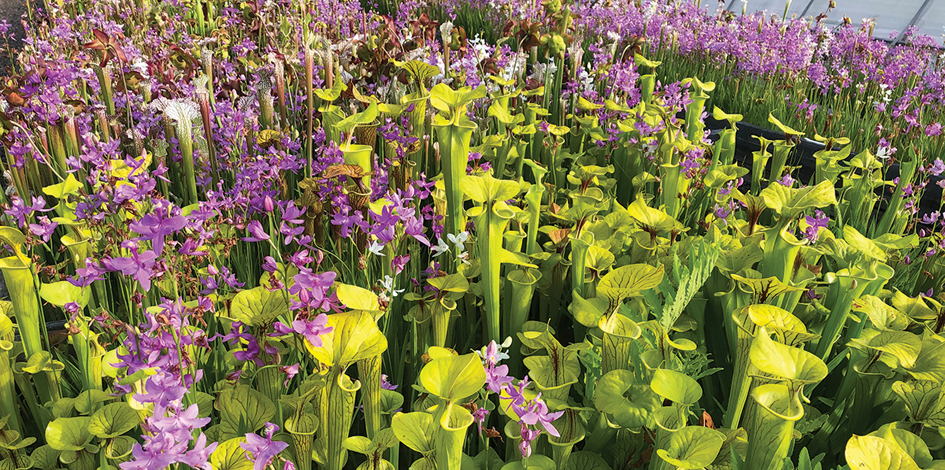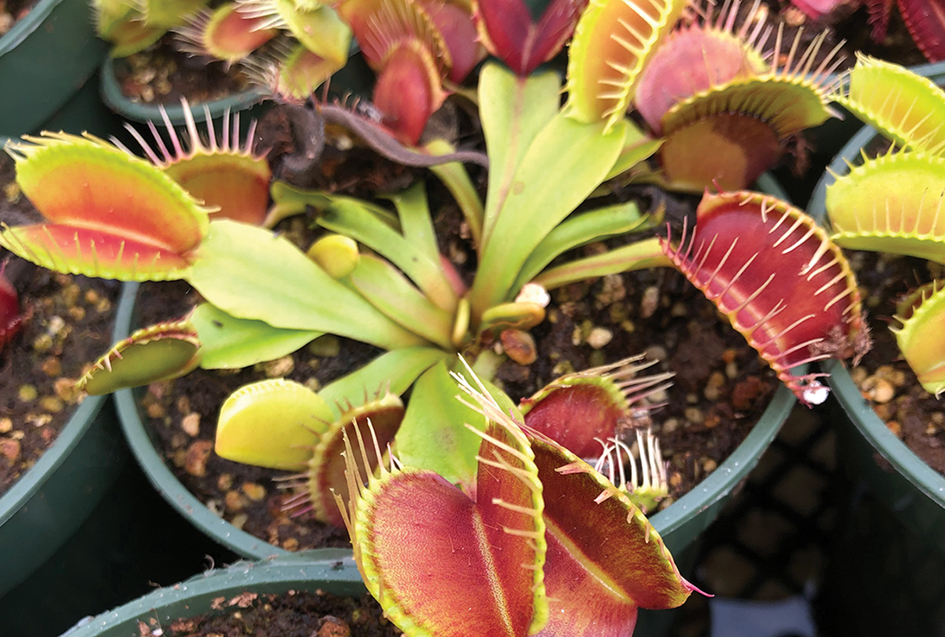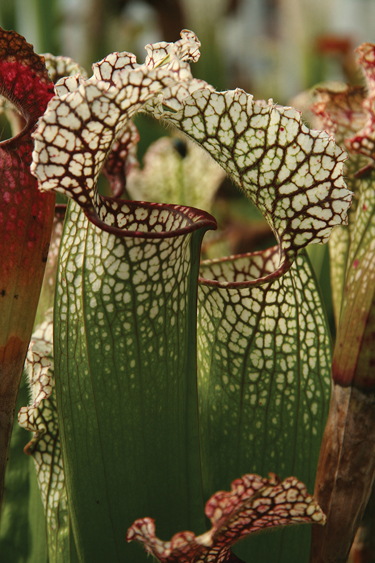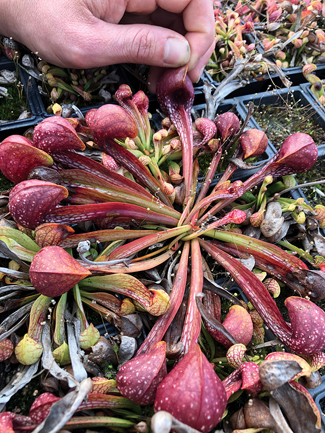
An unsuspecting fly lazily buzzes around in search of food. Passing by some dew drops, it senses something sweet and lands on a little green leaf in a swampy meadow for a closer look. Suddenly, in the blink of an eye, the leaf snaps shut, trapping the fly behind a row of teeth. This insect has now become a nutrient source for the Dionaea muscipula — the Venus flytrap, everyone’s favorite carnivorous plant.
Many people learn about carnivorous plants during grade school, especially the Venus flytrap. From a young age, I was (figuratively) bitten by a passion for these mind-blowing plants that have a seemingly alien-like ability to catch and eat live insects, just like something out of a horror movie. Although sundews (Drosera) and North American pitcher plants (Sarracenia) are less popular, they are more widely distributed throughout the continent (and are just as fascinating, in my opinion).
From my own experience, being a child learning about carnivorous plants was an important factor in elevating my interest in horticulture and biology. No matter what one thinks about carnivorous plants, they are definitely not boring. An early childhood interest in these plants can lead to a lifelong appreciation of botany and biology. About 20 years ago, wetland expert Nick Romanowski reported that less than 2.5% of the natural habitat for Sarracenias now exists.This might create the impression that these plants are exotic and hard to grow, but that’s not the case. These plants are quite easy to grow and maintain throughout the years, and in most states, they can be grown outside, making carnivorous bog gardens an overlooked but fascinating option for gardeners. In nature, carnivorous plants grow in swampy bog environments that constantly retain moisture and receive a lot of sunlight.
>> Find more fantastic Aquatic and Pond Plant articles and ideas here.
Recreating these conditions in the garden can be quite easy, whether in standalone containers, a part of ground bogs, or near the edge of a pond or waterscape. All species of North American carnivorous plants are hardy to at least Zone 6 outdoors. Sarracenia psittacina will survive, while Sarracenia purpurea will thrive, for example.

Candidate Carnivores
Venus flytraps have dazzled humans since their discovery in 1796 by John Ellis. They were extensively studied by Charles Darwin, who used this plant in formulating theories of evolution. They secrete sugary nectar in the inner fold of their leaves. Each contains about eight pressure-sensitive hairs. A buildup of osmotic pressure along the bottom ridge of each leaf or trap holds it open. When the hairs are triggered, the pressure is released, the leaves fold shut, and the ridges of the “teeth” interlock. Digestive juices are secreted to make the prey more palatable. Nutrients that are lacking in the environment are then intracellularly absorbed by the plant as it digests its prey for a period of about five to 10 days. Remarkably, the specialized hairs in a Venus flytrap leaf can distinguish between the feel of prey and that of an inanimate object.
For the gardener who wants a more permanent bog garden as part of their landscape, in-ground bog gardens and bog gardens at the edge of a watercourse work well. Most in-ground bog gardens that we build are between 10 and 12 inches deep and are lined with a rubber or plastic membrane that has perforations.
Drosera, also known as sundews, are the most widely distributed carnivorous plants in the world and can be found on most continents. Thread leaf sundew (D. filiformis), round leaf sundew (D. rotundafolia) and intermediate leaf sundew (D. intermedia) are among the most popular native hardy sundews. The leaves of these plants have tendrils of sticky “glue” that snares unsuspecting and hungry insects. Once trapped onto the leaf, the pressure-sensing tentacles move toward their prey, grabbing hold to ensure no escape. Digestive enzymes secreted by the tentacles help break down the insects into nitrogen-rich fluids that are absorbed through the leaves. Sundews are best at catching small flying insects such as fruit flies, moths and mosquitos.
Pitcher Plants

In my opinion, the shining star of North American carnivorous plants is the pitcher plant, or Sarracenia genus. About 10 species of these passive trapping plants occur throughout most of the continent and range in size from a few inches to 3 feet-plus. Pitcher plants bloom in spring and usually time the growth of their flowers before their tubes are fully formed so that they do not inadvertently trap and eat their pollinators.
Sarracenias are passive trapping plants, meaning they do not move to capture their prey. Instead, they lure insects to the lip around the mouth with a sweet substance. The nectar secreted by these plants has an intoxicating effect on the insects, making them uncoordinated and slow. They inevitably lose their foothold and fall into the tube waiting below. The insides of the tubes are slippery and contain downward-pointing hairs, which make it difficult for prey to escape. Like other carnivorous plants, Sarracenias contain specialized areas that secrete digestive fluids that break down the prey into useful sources of nutrients for the plant.
Here at Aquascapes Unlimited (Bucks County, Southeastern Pennsylvania in Zone 6), we have been working with carnivorous plants, and most notably pitcher plants for more than 20 years. We specialize in carnivorous plants as a wholesale grower and also offer consultation and training in bog construction. Carnivorous plant bogs can be created in container pots, sunk into a plastic or rubber liner in the ground, planted next to the edge of a pond, or even planted on a floating island. A general conception about bog gardens is that their plants grow best when having “wet feet and dry ankles.” This means that the soil in the bog should retain moisture for about a week. Environmental conditions like this are usually replicated by placing an impermeable membrane in the bottom of the bog container with holes spaced out as needed to maintain necessary drainage. It is essential that the roots are oxygenated.
All species of Sarracenia are easily hybridized. Over the past few decades, we have played around with selections to create hybrids that are useful for the cut-flower industry. Cut tubes of pitcher plants can make beautiful bouquets, often looking good in a vase for two weeks or more.How to Grow

Container bog gardens can be grown indoors under lights or on sunny windowsills. Provided they undergo a recommended amount of overwintering, indoor container bogs can be a long-lasting supply of fascination and interest. Through trial and error, we have found that most species of North American carnivorous plants require a minimum dormancy period of about 40 degrees Fahrenheit for at least 40 days. This gives them a chance to go into a period of hibernation, where the roots and rhizomes are able to store energy for flower production in the following spring. We encourage people who keep carnivorous plants indoors year-round to put their container in a garage or shed for at least a month or two during the winter while keeping the media damp. People who live in southern states may provide dormancy by putting their plants in a refrigerator for the same time. Using a 60-40 media composed of pearlite and peat moss works well, and these materials are readily available at most garden centers. Aside from creating interest, indoor container bog gardens can also legitimately function as an organic way to remove insects from one’s house.
For the gardener who wants a more permanent bog garden as part of their landscape, in-ground bog gardens and bog gardens at the edge of a watercourse work well. Most in-ground bog gardens that we build are between 10 and 12 inches deep and are lined with a rubber or plastic membrane that has perforations.
In Southeastern Pennsylvania, we allow for drainage in the top third of the bog. This ensures that the plants are never sitting in a puddle of saturated peat. In outdoor bogs, we like to use silica sand as a substitute for pearlite for the top few inches of the media. Pearlite tends to float to the surface and wash away. Do not use beach or river sand, as this may add minerals.
As far as overwintering, most species of Drosera, Sarracenia and Venus flytraps will survive as long as they have a covering of snow or fabric such as mylar, weed barriers, pine straw or pine branches.
Maintaining bog gardens is surprisingly easy as long as one remembers the three essential components in growing carnivorous plants: pure water and soil, high levels of light and constant moisture. By building a bog garden with sustainably sourced plants, you can create a lifelong interest that contributes to the efforts in preserving this rare community.


